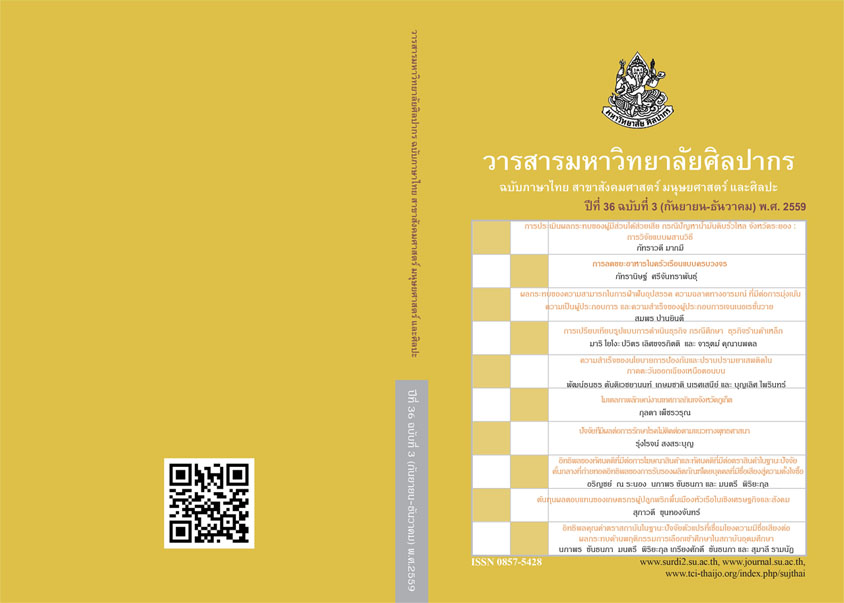อิทธิพลของทัศนคติที่มีต่อการโฆษณาสินค้าและทัศนคติที่มีต่อตราสินค้าในฐานะปัจจัยคั่นกลางที่ถ่ายทอดอิทธิพลของการรับรองผลิตภัณฑ์โดยบุคคลที่มีชื่อเสียงสู่ความตั้งใจซื้อ (Influences of Attitudes towards Product Advertising and Brands as Mediators Transferring Celebrity Endorsement Influences on Purchase Intention)
Main Article Content
Abstract
การวิจัยครั้งนี้มีวัตถุประสงค์ 3 ประการ คือ 1) เพื่อศึกษาการรับรองผลิตภัณฑ์โดยบุคคลที่มีชื่อเสียง ทัศนคติที่มีต่อโฆษณา ทัศนคติที่มีต่อตราสินค้าและความตั้งใจซื้อของผลิตภัณฑ์โตโยต้า 2) เพื่อศึกษาอิทธิพลของทัศนคติที่มีต่อโฆษณาและทัศนคติที่มีต่อตราสินค้าในฐานะปัจจัยคั่นกลางระหว่างการรับรองผลิตภัณฑ์โดยบุคคลที่มีชื่อเสียงและความตั้งใจซื้อ 3) เพื่อเปรียบเทียบอิทธิพลของความเป็นดารานักแสดงและความเป็นผู้รับรองผลิตภัณฑ์ที่มีต่อการเปลี่ยนแปลงอิทธิพลของบุคคลที่มีชื่อเสียงสู่ความตั้งใจซื้อ ผลการวิจัยพบว่าทัศนคติที่มีต่อโฆษณา (attitude towards advertising) และทัศนคติที่มีต่อตราสินค้า (attitude towards brand) นั้นเป็นตัวแปรคั่นกลางที่ถ่ายทอดอิทธิพลจากการรับรองผลิตภัณฑ์โดยบุคคลที่มีชื่อเสียง (celebrity endorsement) ไปยังความตั้งใจซื้อ (purchase intentions) โดยมีความแตกต่างกันตามรูปแบบการรับรองผลิตภัณฑ์ระหว่างความเป็นดารานักแสดง (actor) และความเป็นผู้รับรอง (endorser) อย่างมีนัยสำคัญทางสถิติซึ่งสอดคล้องกับสมมติฐาน นอกจากนี้พบว่าบุคคลที่มีชื่อเสียงที่รับรองผลิตภัณฑ์ระหว่างประเภทดารานักแสดงและประเภทความเป็นผู้รับรองนั้นมีอิทธิพลต่อทัศนคติที่มีต่อโฆษณาผลิตภัณฑ์และตราสินค้าที่แตกต่างกัน นอกจากนี้ผลการวิจัยเชิงคุณภาพพบว่าการรับรองผลิตภัณฑ์โดยบุคคลที่มีชื่อเสียงส่งผลดีต่อทัศนคติที่มีต่อโฆษณาและทัศนคติต่อตราสินค้า เนื่องจากทำให้เกิดการชื่นชอบ จดจำโฆษณาและตราสินค้าได้มากยิ่งขึ้น รวมถึงทำให้เกิดความรู้ความเข้าใจและความเชื่อมั่นในผลิตภัณฑ์และตราสินค้าโตโยต้าเพิ่มขึ้น ซึ่งกระตุ้นให้เกิดความต้องการซื้อและส่งผลให้เกิดการตัดสินใจซื้อผลิตภัณฑ์ในที่สุด
Downloads
Article Details
References
Bruner II, G. C. and Kumar, A. (2000). Web Commercials and Advertising Hierarchy of Effects. Journal of Advertising Research, 40(1&2,): 35-44.
Chen, S. M. and Huddleston, P. (2009). A Comparison of Four Strategies to Promote Fair Trade Products. International Journal of Retail & Distribution Management, 37(4): 336-345.
Choi, S. M. and Rifon, N. J. (2012). It Is a Match: The Impact of Congruence between Celebrity Image and Consumer Ideal Self on Endorsement Effectiveness. Psychology & Marketing, 29(9): 639-650.
Dwivedi, A. and Johnson, L. W. (2013). Trust–commitment as a Mediator of the Celebrity Endorser–Brand Equity Relationship in a Service Context. Australasian Marketing Journal (AMJ), 21(1): 36-42.
Fink, J. S., Parker, H. M., Cunningham, G. B., and Cuneen, J. (2012). Female Athlete Endorsers: Determinants of Effectiveness. Sport Management Review,15(1): 13-22.
La Ferle, C. and Choi, S. M. (2005). The Importance of Perceived Endorser Credibility in South Korean Advertising. Journal of Current Issues & Research in Advertising, 27(2): 67-81.
Mazodier, M. and Quester, P. (2010). Ambush Marketing Disclosure Impact on Attitudes toward the Ambusher's Brand. Recherche et Applications en Marketing (English Edition), 25(2): 51-67.
Muda, M., Musa, R., Mohamed, R. N., and Borhan, H. (2014). Celebrity Entrepreneur Endorsement and Advertising Effectiveness. Procedia-Social and Behavioral Sciences, 130: 11-20.
Muehling, D. D. (1987). An Investigatation of Factors Underlying Attitudes-Toward-Adversting-In-General. Journal of Advertising, 26(1): 32-40.
Ohanian, R. (1990). Construction and Validation of a Scale to Measure Celebrity Endorsers' Perceived Expertise, Trustworthiness, and Attractiveness. Journal of Advertising, 19(3): 39-52.
Petrovici, D., Marinova, S., Marinov, M., and Lee, N. (2007). Personal Uses and Perceived Social and Economic Effects of Advertising in Bulgaria and Romania. International Marketing Review, 24(5): 539-562.
Pollay, R. W. and Mittal, B. (1993). Here's the Beef: Factors, Determinants, and Segments in Consumer Criticism of Advertising. The Journal of Marketing: 99-114.
Radder, L., Pietersen, J., Wang, H., and Han, X. (2010). Antecedents of South African High School Pupils’ Acceptance of Universities’ SMS Advertising. International Business & Economics Research Journal (IBER), 9(4).
Roozen, D. (2009). Faith Communities Today 2008: A First Look. Hartford: Hartford Institute for Religion Research. Hartford: Hartford Seminary.Soderlund, M. and Dahlen, M. (2010). The “Killer” Ad: An Assessment of Advertising Violence. European Journal of Marketing, 44(11/12): 1811-1838.
Singh, S. J., Kumari, G., Singh, K., and Rani, S. (2000). Deformation of Two Welded Half-Spaces due to Inclined Shear and Tensile Point Dislocations and a Centre of Dilation. Physics of the Earth and Planetary Interiors, 122: 251–267.
Spry, A., Pappu, R., and Cornwell, T.B. (2011). Celebrity Endorsement, Brand Credibility and Brand Equity. European Journal of Marketing, 45(6): 882-909.
Tseng, L. Y. and Lee, T. S. (2013). Investigating the Factors Influence Tweens’ Purchase Intention through Peer Conformity in Taiwan. Advances in Management and Applied Economics, 3(3): 259.
Wang, X. (2012). Attitude toward the Advertising and Subjective Norm on Purchase Intention: A Case of Television Advertising of Beauty and Personal Care Products in Bangkok. Doctoral dissertation, University of the Thai Chamber of Commerce, Bangkok, Thailand.
Veer, E., Becirovic, I., and Martin, B. A. (2010). If Kate Voted Conservative, Would You? The Role of Celebrity Endorsements in Political Party
Advertising. European journal of marketing, 44(3/4): 436-450.


